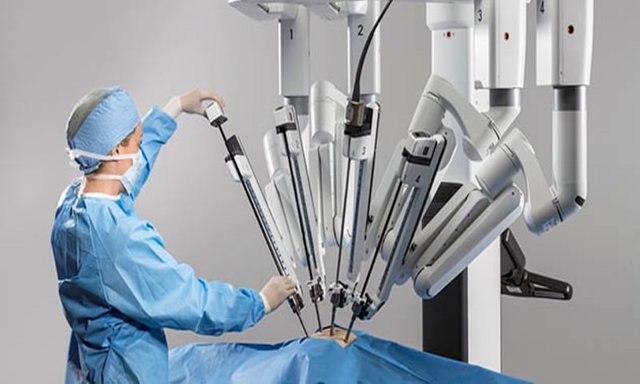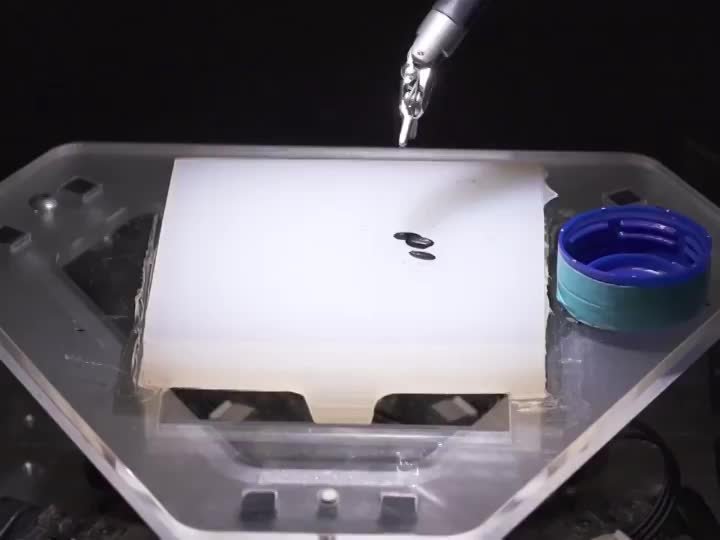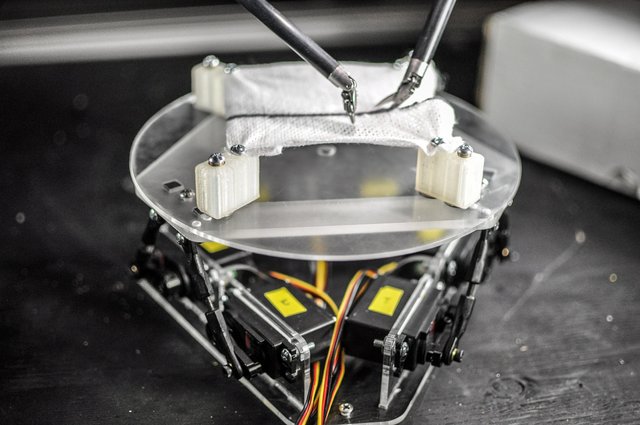ROBOTS TURN INTO SURGEONS THROUGH FLIGHT SIMULATION TECH

THE ROBOTIC PLATFORM heaves, as if breathing. On top of it stretches a piece of white-colored gauze having a blue line painted straight down the middle. Along this particular line an additional robot snips with small surgical scissors, awaiting the system to come to a brief rest before finally make a cut. And another snip, and rest. And another, and rest, on down the line.

This could be you some day. Not that you will turn into a robot-you may go under the knife of a machine operating like a surgical assistant. And it’s machines like this heaving automatic platform-actually adapted from the technology which powers flight simulators-that you will need to thank.
A subtle problem of operating on humans is the fact that their lungs keep breathing and their hearts keep beating-that is, if the surgeon is doing their work right. When the chest heaves or even blood pumps, the surgeon needs to compensate for that movement.
This new robot mimics that movement. It’s a type of a Stewart platform, a usually hefty pneumatic device that powers things such as immersive flight simulators. However for this study, the experts took the idea and shrunk it right down to a 6-inch-wide device, opting for servo motors rather than pneumatic power. The machine costs simply $250.

Bogus patient in hand, the researchers very first experienced a human practice cutting on it in a straight line with the da Vinci surgery robot. “We had this fine sinusoidal motion of this platform, some thing mimicking a heart beat, and that we anticipated him to follow the motion,” says UC Berkeley computer scientist Sanjay Krishnan. “Instead he would wait for the platform to come back to a particular position after which do something really rapidly, and then wait again.” Which means, rather than continuously cutting, the surgeon waited for the machine to reach a lull, then cut.
The researchers took the information from viewing the surgeon's actions and developed algorithms which could mimic his technique for cutting along a line. Additionally they created algorithms for cutting constantly, without waiting for lulls. “If you were to design an algorithm to precisely track the motion, first it fails a couple times where it outright misses the line,” says Krishnan. This technique of continuously cutting can also be more than two times as incorrect as what the surgeon confirmed.

However the surgeon’s way does come at a cost: For the robot it is about twice as slow as continuously cutting because the algorithm is actually waiting to time its cuts right. Good news, though: one of the excellent promises of robotics is the possibility of speed. Algorithms will simply get better, as will the capabilities of the hardware.

Surgery robots will not simply have to worry about the body’s natural motions, either. Breathing lungs and beating hearts produce fairly constant motions compared to, say, a nurse bumping the patient while the robot is operating. That is a particularly pressing problem because these robots will not be made to replace surgeons, but to work together with them. “I don't believe we will actually replace surgeons,” says UC Berkeley roboticist Ken Goldberg, who helped develop the new system. “I don't want to overstate this at all, however I believe it's a step toward having the ability to do more subtasks in more realistic settings.”

To perform more subtasks, a surgery robot would need to get more flexible. For instance, it’d need to eyeball different kinds of tissues that transform as the procedure progresses. “In surgery, you are not just dealing with deformable objects, where they sort of change shape, they modify color, all kinds of things depending on exactly how your digital camera is looking at them,” says Krishnan. Context is paramount-training the machines to parse a dynamic environment.
And even if robots are up to the challenges associated with this type of sensitive job, their creators will need to convince surgeons that they need the machines. “Surgeons by description, we're creatures of habit,” says pediatric surgeon Peter Kim, who studies surgical robots. “At the same time under the pretext of wanting what's best, what's safest for the patient, we tend to be fairly conservative.”
“I believe once we gain more and more confidence and trust in these types of technologies, we will acknowledge that yes, we will work with the machines,” Kim adds. “And perhaps in the not too faraway future the machines is going to do significant parts of it and do it much better.”
For now, though, the robots stay in the early times of medical school. But if you are a piece of gauze, at least, the doctor is in.
Hi. I am a bot that looks for newbies who write good content!
Your post passed all of my tests.
You get:
I also write bots and other code for crypto....
Resteemed by @resteembot! Good Luck!
The resteem was paid by @greetbot
Curious? Read @resteembot's introduction post
Check out the great posts I already resteemed.
ResteemBot's Maker is Looking for Work.